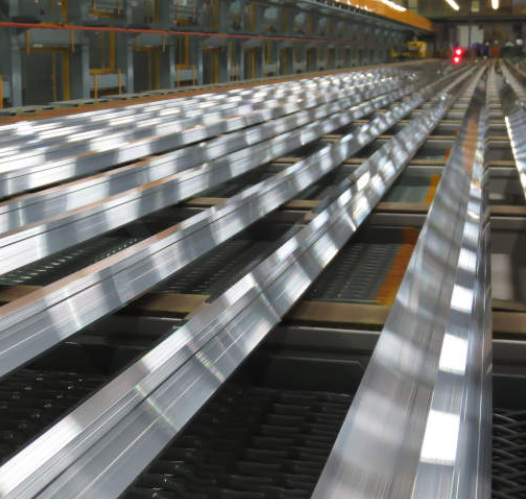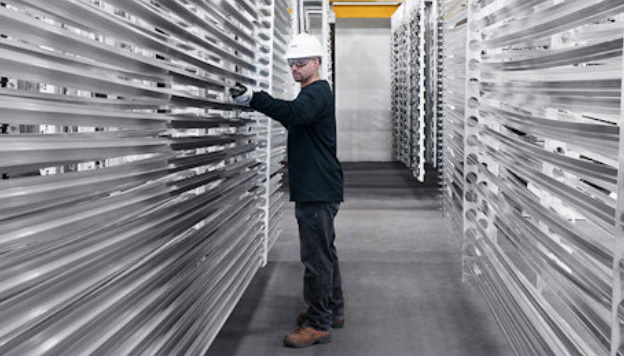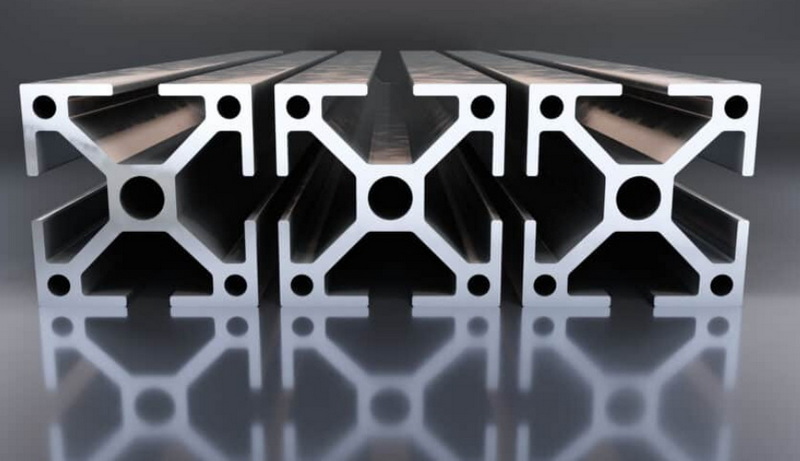Content Menu
● The Aluminum Extrusion Process
● Advantages of Aluminum Extrusion
>> 1. Design Flexibility
>> 2. Strength-to-Weight Ratio
>> 3. Corrosion Resistance
>> 4. Cost-Effectiveness
● Impact on Product Quality
>> Precision and Consistency
>> Enhanced Strength
>> Surface Finish
● Efficiency Improvements
>> Reduced Material Waste
>> Faster Production
>> Energy Efficiency
● Applications Across Industries
>> Automotive Industry
>> Aerospace Industry
>> Construction Industry
>> Electronics Industry
● The Role of Aluminum Extrusion Plants
>> Advanced Technology in Aluminum Extrusion Plants
>> Sustainability in Aluminum Extrusion Plants
● Future Trends in Aluminum Extrusion
● Conclusion
● Frequently Asked Questions
>> 1. What is the difference between hot and cold aluminum extrusion?
>> 2. How does aluminum extrusion contribute to sustainability?
>> 3. What are the limitations of aluminum extrusion?
>> 4. How does the aluminum extrusion process affect the mechanical properties of the final product?
>> 5. What advancements can we expect in aluminum extrusion technology in the near future?
● Citations:
Aluminum extrusion is a versatile manufacturing process that has revolutionized various industries by offering numerous benefits in terms of product quality and efficiency. This article delves into the intricacies of aluminum extrusion, exploring its impact on product development, manufacturing processes, and overall industrial productivity.

The Aluminum Extrusion Process
Aluminum extrusion is a technique used to create objects with a fixed cross-sectional profile. The process involves pushing heated aluminum through a die of the desired cross-section. Let's examine the steps involved in this fascinating process:
1. Heating the Billet: The process begins with heating an aluminum billet to nearly 900°F (482°C)[1].
2. Pressing: The heated billet is then placed in a container in the extrusion press.
3. Extrusion: A hydraulic ram pushes the softened aluminum through a die, creating the desired profile[1].
4. Cooling: The extruded profile is cooled using air or water quenching[1].
5. Stretching and Cutting: The profile is stretched to straighten it and cut to the required length[1].
6. Heat Treatment: Finally, the extrusion undergoes heat treatment to achieve the desired properties[1].
Advantages of Aluminum Extrusion
1. Design Flexibility
Aluminum extrusion offers unparalleled design flexibility. It allows for the creation of complex shapes and profiles that would be difficult or impossible to achieve through other manufacturing methods[2]. This flexibility enables designers to optimize product performance and aesthetics simultaneously.
2. Strength-to-Weight Ratio
One of the most significant advantages of aluminum extrusion is the excellent strength-to-weight ratio of the final product. This property makes extruded aluminum components ideal for applications where weight reduction is crucial, such as in the automotive and aerospace industries[2].
3. Corrosion Resistance
Extruded aluminum naturally forms a protective oxide layer, making it highly resistant to corrosion. This characteristic ensures the longevity of the product, even in harsh environments[2].
4. Cost-Effectiveness
Despite its numerous benefits, aluminum extrusion remains a cost-effective manufacturing solution. The efficiency of the process, combined with aluminum's abundance and recyclability, keeps production costs competitive[9].
Impact on Product Quality
Aluminum extrusion significantly enhances product quality in several ways:
Precision and Consistency
The extrusion process allows for high precision and consistency in the production of components. This precision is crucial in industries where tight tolerances are required, such as aerospace and electronics[1].
Enhanced Strength
The extrusion process aligns the grain structure of the aluminum, resulting in increased strength along the length of the profile. This enhanced strength contributes to the overall quality and durability of the final product[1][9].
Surface Finish
Aluminum extrusion can produce components with excellent surface finishes right out of the die. This reduces or eliminates the need for additional finishing processes, saving time and resources[7].

Efficiency Improvements
Aluminum extrusion contributes to manufacturing efficiency in several ways:
Reduced Material Waste
The extrusion process is highly efficient in terms of material usage. Unlike subtractive manufacturing methods, extrusion minimizes material waste, as the aluminum is shaped rather than cut away[1][3].
Faster Production
Compared to other manufacturing methods, aluminum extrusion offers faster production times. The process can produce complex shapes in a single step, eliminating the need for multiple manufacturing stages[2].
Energy Efficiency
Aluminum extrusion requires less energy compared to other metal forming processes. The lower melting point of aluminum and the efficiency of the extrusion process contribute to overall energy savings[1].
Applications Across Industries
The benefits of aluminum extrusion have led to its widespread adoption across various industries:
Automotive Industry
In the automotive sector, aluminum extrusions are used for structural components, body frames, and heat exchangers. The lightweight nature of extruded aluminum contributes to improved fuel efficiency and reduced emissions[6].
Aerospace Industry
The aerospace industry utilizes aluminum extrusions for aircraft fuselages, wings, and landing gear components. The high strength-to-weight ratio of extruded aluminum is particularly valuable in this sector[3].
Construction Industry
In construction, aluminum extrusions are used for window frames, door frames, and curtain walls. The corrosion resistance and durability of extruded aluminum make it an ideal choice for these applications[2].
Electronics Industry
The electronics industry benefits from aluminum extrusions in the form of heat sinks and enclosures. The excellent thermal conductivity of aluminum helps in efficient heat dissipation[9].
The Role of Aluminum Extrusion Plants
Aluminum extrusion plants play a crucial role in the manufacturing ecosystem. These facilities are equipped with state-of-the-art machinery and technology to produce high-quality extruded aluminum products efficiently.
Advanced Technology in Aluminum Extrusion Plants
Modern aluminum extrusion plants utilize advanced technologies to enhance product quality and production efficiency:
1. Computer-Controlled Extrusion Presses: These presses ensure precise control over the extrusion process, resulting in consistent product quality[3].
2. Automated Material Handling Systems: These systems improve efficiency by reducing manual labor and minimizing the risk of damage to the extruded products[3].
3. In-Line Quality Control Systems: Advanced quality control systems, including laser measurement tools and X-ray inspection equipment, ensure that each extruded product meets the required specifications[7].
4. Energy Recovery Systems: Many aluminum extrusion plants implement energy recovery systems to capture and reuse heat generated during the extrusion process, improving overall energy efficiency[1].
Sustainability in Aluminum Extrusion Plants
Aluminum extrusion plants are increasingly focusing on sustainability:
1. Recycling: Many plants have on-site recycling facilities to process scrap aluminum, reducing waste and conserving resources[2].
2. Water Management: Advanced water treatment and recycling systems help reduce water consumption in the extrusion process[3].
3. Emissions Control: Modern aluminum extrusion plants implement stringent emissions control measures to minimize their environmental impact[9].
Future Trends in Aluminum Extrusion
The aluminum extrusion industry continues to evolve, with several exciting trends on the horizon:
1. Advanced Alloys: Development of new aluminum alloys with enhanced properties for specific applications[2].
2. 3D Printing Integration: Combining aluminum extrusion with 3D printing technologies for more complex and customized components[9].
3. Smart Manufacturing: Implementation of IoT and AI technologies in aluminum extrusion plants for improved process control and predictive maintenance[6].
4. Lightweight Design: Continued focus on lightweight design solutions, particularly for the automotive and aerospace industries[6].
5. Green Technologies: Further advancements in sustainable manufacturing practices and recycling technologies[9].
Conclusion
Aluminum extrusion has proven to be a game-changer in manufacturing, offering significant improvements in product quality and efficiency. Its ability to create complex shapes with high precision, combined with the inherent properties of aluminum, makes it an ideal choice for a wide range of applications.
The process not only enhances product performance through improved strength-to-weight ratios and corrosion resistance but also contributes to manufacturing efficiency through reduced material waste and faster production times. As aluminum extrusion plants continue to adopt advanced technologies and sustainable practices, the industry is well-positioned to meet the evolving demands of various sectors.
The future of aluminum extrusion looks promising, with ongoing developments in alloy technology, manufacturing processes, and sustainability practices. As industries continue to seek lightweight, durable, and cost-effective solutions, aluminum extrusion will undoubtedly play a crucial role in shaping the future of manufacturing.

Frequently Asked Questions
1. What is the difference between hot and cold aluminum extrusion?
Hot extrusion is performed at temperatures around 900°F (482°C), allowing for more complex shapes and larger cross-sections. Cold extrusion is done at room temperature or slightly elevated temperatures and is typically used for smaller, simpler shapes with tighter tolerances[1].
2. How does aluminum extrusion contribute to sustainability?
Aluminum extrusion contributes to sustainability through its efficient use of materials, the recyclability of aluminum, and the energy efficiency of the process. Many aluminum extrusion plants also implement sustainable practices such as recycling scrap and using energy recovery systems[2][9].
3. What are the limitations of aluminum extrusion?
While versatile, aluminum extrusion has some limitations. These include size constraints based on press capacity, potential for surface imperfections in complex shapes, and limitations in creating certain features like undercuts without secondary operations[7].
4. How does the aluminum extrusion process affect the mechanical properties of the final product?
The extrusion process aligns the grain structure of the aluminum, which can enhance strength along the length of the profile. The cooling rate and subsequent heat treatment also play crucial roles in determining the final mechanical properties of the extruded product[1][9].
5. What advancements can we expect in aluminum extrusion technology in the near future?
Future advancements in aluminum extrusion technology may include the development of new alloys with enhanced properties, integration with additive manufacturing techniques, implementation of AI and IoT for process optimization, and further improvements in energy efficiency and sustainability practices[2][6][9].
Citations:
[1] https://www.tensilemillcnc.com/blog/12-major-benefits-of-aluminum-extrusions
[2] https://elkamehr.com/en/aluminum-extrusion-process-benefits-and-applications/
[3] https://www.tensilemillcnc.com/blog/the-most-efficient-aluminum-extrusion-process-with-precise-quality-control-will-guarantee-the-best-results-of-your-production
[4] https://www.alamy.com/stock-photo/aluminum-extrusion.html
[5] https://www.istockphoto.com/de/bot-wall?returnUrl=%2Fde%2Fphotos%2Faluminum-extrusion
[6] https://www.youtube.com/watch?v=lWWlLIW9tgA
[7] https://starext.com/news/aluminum-extrusion-finishing-fabrication-frequently-asked-questions-faq
[8] https://dajcor.com/learning-centre/faq
[9] https://simmal.com/the-advantages-of-aluminium-extrusion-in-manufacturing/
[10] https://www.youtube.com/watch?v=P8BWQBP4Vhk






















